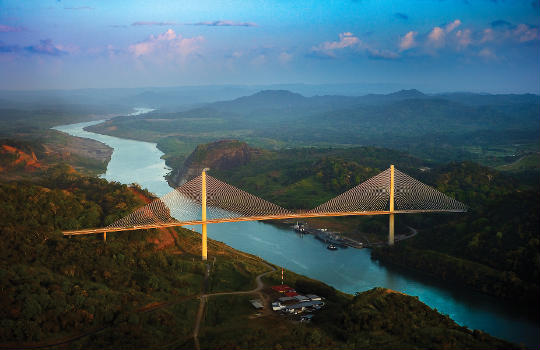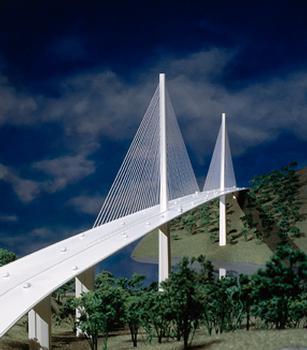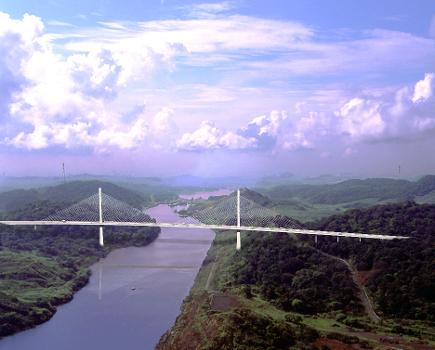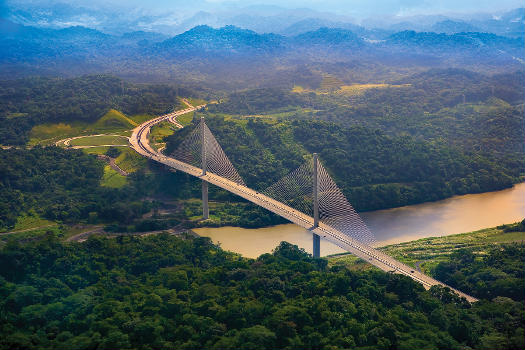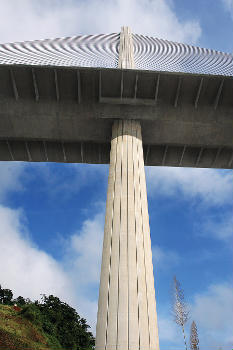General Information
| Name in local language: | Puente Centenario |
|---|---|
| Beginning of works: | 2002 |
| Completion: | 15 August 2004 |
| Status: | in use |
Project Type
| Structure: |
Cable-stayed bridge with semi-fan system |
|---|---|
| Function / usage: |
Road bridge |
| Material: |
Concrete bridge |
| Structure: |
Three-span cable-stayed bridge |
| Plan view: |
Structurae Plus/Pro - Subscribe Now! |
| Support conditions: |
for registered users |
| Material: |
Prestressed concrete bridge |
| Material: |
Structurae Plus/Pro - Subscribe Now! Structurae Plus/Pro - Subscribe Now! |
| Secondary structure(s): |
Structurae Plus/Pro - Subscribe Now! |
| Secondary structure(s): |
Structurae Plus/Pro - Subscribe Now! |
Location
| Location: |
Paraíso, Panamá, Panama West Panama, Panama |
|---|---|
| Crosses: |
|
| Part of: | |
| Coordinates: | 9° 1' 53" N 79° 38' 5" W |
Technical Information
Dimensions
| total length | 1 052 m | |
| span lengths | 2 x 60.0 m - 66.0 m - 200.0 m - 420.0 m - 200 m - 46.0 m | |
| number of spans | 7 | |
| number of lanes | 2 x 3 | |
| vertical navigation clearance | 80.0 m | |
| horizontal navigation clearance | 70.0 m | |
| abutments | number | 2 |
| deck | deck width | 34.10 m |
| piers | number | 6 |
| main bridge | ||
|---|---|---|
| main span | 420 m | |
| length | 820 m | |
| number of cables | 128 | |
| number of lanes | 2 x 3 | |
| deck | deck depth | 4.50 m |
| stay anchor spacing | 6 m | |
| pylons | height | 184 m |
| stay anchor spacing | 1.5 m | |
| pylon height (above deck) | 94 m | |
| number | 2 | |
Quantities
| main bridge | ||
|---|---|---|
| steel for cable-stays | 1 320 t | |
Design Loads
| live load | HS-25 | |
| design code(s) | AASHTO |
Materials
| deck |
prestressed concrete
|
|---|---|
| piers |
reinforced concrete
|
| pylons |
reinforced concrete
|
| abutments |
reinforced concrete
|
Chronology
| 3 July 2004 | Final pour closes the deck. |
|---|---|
| 15 August 2004 | Opening. |
Description
Puente Centenario is a slender cable-stayed bridge carrying six lanes of traffic across the Panama Canal. The bridge has one of the longest spans of its kind in Central and South America. The vertical navigational clearance allows large vessels to pass below and accommodates the canal expansion in 2016. The towers support a single plane of cables anchored along the median. The bridge is visible from great distances and contrasts dramatically with the surrounding rainforest. Aesthetic lighting illuminates the towers at night, making the bridge the sole focal point in an otherwise dark setting. Designed throughout to appear modern, streamlined, and elegant, the Puente Centenario is a fitting landmark for Panama and ist people.
Excerpt from Wikipedia
Panama's Centennial Bridge (Spanish: Puente Centenario) is a major bridge crossing the Panama Canal. It was built to supplement the overcrowded Bridge of the Americas and to replace it as the carrier of the Pan-American Highway. Upon its opening in 2004, it became the second permanent crossing of the canal.
Description
The Centennial Bridge is the second major road crossing of the Panama Canal, the first being the Bridge of the Americas. (Small service bridges are built in the lock structures at Miraflores and Gatún Locks, but these bridges are only usable when the lock gates are closed and have limited capacity.)
The Centennial Bridge is located 15 km (9.3 mi) north of the Bridge of the Americas and crosses the Culebra Cut (Gaillard Cut) close to the Pedro Miguel locks. New freeway sections, connecting Arraijan in the west to Cerro Patacon in the east via the bridge, significantly alleviate congestion on the Bridge of the Americas.
History
The Bridge of the Americas, which opened in 1962, was the only major road crossing of the Panama Canal. The traffic over this bridge was originally around 9,500 vehicles per day; however, this expanded over time, and by 2004 the bridge was carrying 35,000 vehicles per day.
Since the bridge represented a major bottleneck in the Pan-American Highway, Panama's Ministry of Public Works requested tenders for a second canal crossing in October 2000.[unreliable source?] The contract to build a replacement bridge was awarded in March 2002. An ambitious schedule of just 29 months was set for construction, so that the bridge could open on the 90th anniversary of the first ship transit of the Panama Canal by the cargo ship Ancon, on 15 August 1914. The bridge was named for Panama's centennial, which occurred on 3 November 2003.
The new bridge was designed by a joint venture between T.Y. Lin International and the Louis Berger Group Inc, and constructed by German-based Bilfinger Berger Ingenieurbau GmbH using resources from its Australian subsidiary Baulderstone Hornibrook. The architects were Elle Sokolow working as an Architect for Geiger-Berger Associates and the Boston-based transportation architect Miguel Rosales from Rosales + Partners who created the concept and initial aesthetic designs for the Panama-Centennial Bridge. Structural engineering contracts were awarded to Leonhardt, Andrä and Partner.
The bridge was inaugurated on schedule on 15 August 2004, although it was opened for traffic on 2 September 2005, when the new highways leading to it were finished.
Part of the access to the Centennial Bridge collapsed in December 2010, following heavy rain and flooding. In November 2011 full traffic was restored.
Construction
The bridge is a cable-stayed design with a total span of 1,052 m (3,451 ft). The main span is 420 m (1,380 ft) and clears the canal by 80 m (260 ft), allowing large vessels to pass below it. The bridge is supported by two towers, each 184 m (604 ft) high. The deck carries six lanes of traffic across the canal.
The Centennial Bridge is designed to withstand the earthquakes which are frequently recorded in the canal area. It was built by the German construction firm Bilfinger.
The West Tower was built about 50 m inland to allow space for the future widening of the Panama Canal.
Awards
- 2005 Bridge Award of Excellence, American Segmental Bridge Institute (ASBI).
- 2007 Merit Award, Consulting Engineers and Land Surveyors of California (CELSOC)
Text imported from Wikipedia article "Centennial Bridge, Panama" and modified on October 7, 2024 according to the CC-BY-SA 4.0 International license.
Participants
- Miguel Rosales (architect)
Relevant Web Sites
Relevant Publications
- (2007): Cable-stayed Bridges across the Panama Canal and the Orinoco. Presented at: IABSE Symposium: Improving Infrastructure Worldwide, Weimar, Germany, 19-21 September 2007, pp. 56-57.
- (2007): Design and Construction Innovations for the Puente Centenario, Panamá. Presented at: IABSE Symposium: Improving Infrastructure Worldwide, Weimar, Germany, 19-21 September 2007, pp. 234-235.
- Entre deux Amériques. In: Sols et Structures, n. 220 ( 2004), pp. 16-17.
- (2004): Flying pace. In: Bridge Design & Engineering, v. 10, n. 35 (2nd Quarter 2004), pp. 41-42.
- Freyssinet cable-stayed structures. Freyssinet International, Vélizy-Villacoublay (France), 2004, pp. 73.
- About this
data sheet - Structure-ID
20006023 - Published on:
06/10/2002 - Last updated on:
03/10/2024

